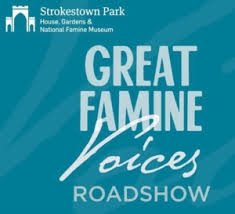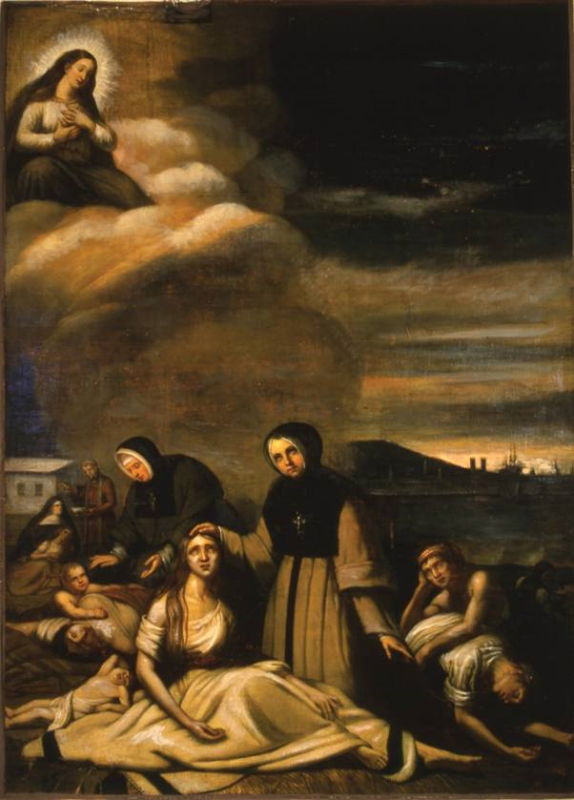The Great Famine Voices Roadshow was welcomed to Montreal by Fergus Keyes and Victor Boyle, Directors of the Montreal Irish Memorial Park Foundation who also organize the annual “Walk to the Black Rock” Famine commemorative procession. The Black Rock marks the site of the fever sheds and Famine Irish burial ground in Montreal where six thousand emigrants died of “ship fever” (typhus) and related diseases during the summer of 1847, the largest Famine grave yard outside of Ireland. The Black Rock was erected in 1859 by Irish labourers working on the city’s Victoria Bridge, many of them survivors of the Great Hunger. It is one of the oldest Famine monuments in the world. Every year, Montreal’s Irish community makes an annual pilgrimage to the Black Rock to mourn and pay tribute to their Famine Irish ancestors during the walk to the stone. The “Walk to the Black Rock” began in 1865 and is one of the oldest Famine commemorative processions in the world.
The Famine Irish and the Grey Nuns
During the summer of 1847, the Famine Irish were cared for by the Grey Nuns and several other French-Canadian female religious orders in the fever sheds of Montreal, several of whom perished while nursing to the sick. Their stories have been recorded in their religious annals which provide the most compelling and detailed eyewitness accounts of the arrivals of Famine emigrants in North America. These annals have been transcribed and translated into English in the Digital Irish Famine Archive which also pays tribute to those who cared for Irish Famine emigrants. They tell the story of the Grey Nuns of Montreal, or Sisters of Charity, who first tended to Irish Famine emigrants, especially widows and orphans, in the city’s fever sheds in 1847 and 1848. It also includes testimonies from Irish Famine orphans, such as Patrick and Thomas Quinn, and Daniel and Catherine Tighe, who were among the missing 1,490 Strokestown emigrants and adopted by French-Canadian families. The Digital Irish Famine Archive can be found at this link.
The story of the Famine Irish in Montreal and the Grey Nuns and female religious orders who cared for them in the city’s fever sheds was also recorded in the 1847 Théophile Hamel painting Le Typhus (left).
Victor Boyle, Director, Montreal Irish Memorial Park Foundation, on the untold story and sacrifice of Montreal’s Mayor John Easton Mills and Grey Nuns who gave their lives caring for Irish Famine emigrants in Montreal’s fever sheds in 1847.
Quebec’s Famine Orphans
The Great Famine Voices Roadshow in Montreal also heard from Veronica Fiztmorris, who lives in Quebec City. She is descended from Irish Famine orphan Catherine Leonard, Tillyallen parish, County Louth, whose parents Nicolas Leonard and Mary Carlin died on the Greenock during the trans-Atlantic voyage in 1847. Catherine Leonard (12), her sister Anne (14), and her brother Michael (10) were adopted from Grosse Isle quarantine station by Robert Duncan, James Farrell, and Patrick Farrell respectively of Frampton, Quebec. Her younger sister Judith died on Grosse Isle on September 7th, 1847; her brother Nicolas (4) disappeared.
Canada’s First Nations and Irish Famine Relief
Walk to the Black Rock
In 2018, the Great Famine Voices Roadshow joined Montreal’s annual “Walk to the Black Rock”. The following dignitaries were on the walk:
Chief Christine Zachary-Deon, Mohawk Band Council, Kahnawake
The Mayor of Montreal, Valérie Plante
The Lord Mayor of Dublin, Mícheál MacDonncha
Deputy Head of Mission, Embassy of Ireland, Ottawa, Michael Hurley
Member of Parliament, Marc Miller, for Ville-Marie-Le Sud-Ouest-Île-des-Soeurs
The Trinitones a capella group (Trinity College Dublin) who performed “The Fields of Athenry” Famine song.
Great Famine Voices Roadshow Montreal after the Walk to the Black Rock
After the Walk to the Black Rock, several of these dignitaries explained the significance of Montreal’s Famine commemorative site for the wider Irish diaspora to the Great Famine Voices Roadshow.
Michael Hurley, Deputy Head of Mission, Embassy of Ireland, Canada.
As Michael Hurley, Deputy Head of Mission at the Embassy of Ireland, Canada, notes:
“It is Irish Government policy to commemorate the Famine both at home and across the Irish diaspora world wide. In recent years we have welcomed two ministers here for that particular purpose, to Ireland Park in Toronto, and throughout the Maritime provinces. The Embassy always tries to work with communities across Canada in promoting the commemoration of this important chapter in our shared history. We look forward to continuing this, and we see the Great Famine Voices Roadshow as a very worthy and important contribution to that process.”
Dublin Lord Mayor, Mícheál Mac Donncha
The Lord Mayor of Dublin, Mícheál Mac Donncha, also participated in the Great Famine Voices Roadshow in Montreal. He echoed Michael Hurley’s sentiments in attesting to the importance of the Roadshow as a vehicle for extending the reach of Irish government policy in supporting famine commemoration at a grass-roots level. In his own words: “The importance of famine commemoration is recognized by the Great Famine Voices Roadshow and I welcome them on their tour. These voices need to be heard”.


